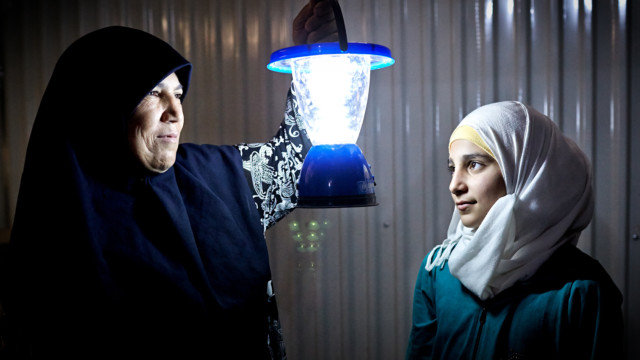At a camp for Syrian refugees in Jordan, renewable solar energy may help return some normalcy for those living in limbo.
More than five million refugees have fled the war in Syria since 2011. Most of them have sought exile in the neighboring countries of Turkey, Lebanon, and Jordan.
The Al Azraq refugee camp in Jordan was opened in April 2014, built by the United Nations High Commissioner for Refugees and the Jordanian government. It’s home to almost 36,000 Syrian refugees. Over half are children.
Though the camp layout was designed to simulate Syrian villages, the structures are still temporary and the facilities are barebones.

Al Azraq is home to over 36,000 Syrian refugees. Without electricity, camp residents have trouble cooling their homes in a desert that reaches over 100 degrees fahrenheit in the summer.
For most of it’s existence, the Al Azraq refugee camp was not connected to Jordan’s electrical grid. Because of this, residents have had to light their homes with small solar lamps; With no refrigeration, preserving food was a constant challenge; Without air conditioning, refugees had difficulty cooling their homes in a desert region that reaches over 100 degrees fahrenheit in the summer.
But in May, a new two-megawatt solar photovoltaic plant turned on the lights. The plant promises to provide electricity to at least 20,000 camp residents, with plans to expand in the future.

For most of it’s existence, the Al Azraq refugee camp was not connected to Jordan’s electrical grid.
Because of this, residents have had to light their homes with small solar lamps.
This solar farm was built through the UNHCR and the a $9.6 million contribution from the IKEA Foundation’s “Brighter Lives for Refugees” campaign. It will provide up to $1.5 million a year in savings, which they plan to use for other humanitarian efforts at Al Azraq.
Per Heggenes, IKEA CEO, spoke at the solar plant launch on May 17.
“This is the first time ever that we inaugurate a solar farm in a refugee camp and it’s a paradigm shift in a way when you think about how all of us support the humanitarian sector in support of the displaced people.”

The solar plant at Al Azraq, Jordan promises to bring electricity to both the refugee camp – and the neighboring communities.
Having access to electricity will help camp residents return to the basic daily activities they knew before escaping Syria, such as cooking, washing clothes, studying or working in the evening – or even walking around the camp safely at night.
“The situation was before, what can I say. We wouldn’t stay up,” said Badrea al Jarbah, a refugee from Homs. “We’d stay up until 7pm and then go to sleep like chickens, but now we’re staying up until 3, 2am in the morning with presence of the electricity.”
Any surplus electricity from the solar plant will be sent to Jordan’s grid for nearby communities to use for free. Electricity will also allow residents to build their temporary community by opening new schools, restaurants or other small businesses.

A shopkeeper at “Sweets of Goodness” in Al Azraq hands out ice cream cones to camp residents after the new solar grid was put online.
Ahmad Abu Rukbeh, “Sweets of Goodness” dessert shop owner and refugee, says the new electricity allows him to bring more simple pleasures to the community at Al Azraq.
“We used to make simple things that we could with our hands, not all the desserts that we have now. Now with the availability of electricity we are making all types of sweets.”
 CGTN America
CGTN America
